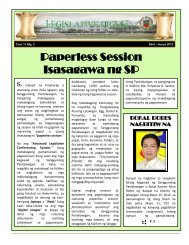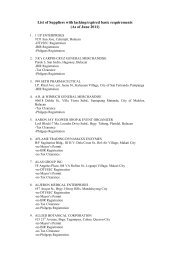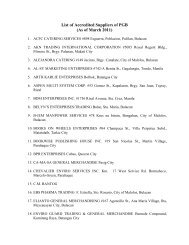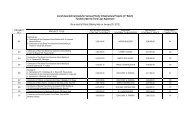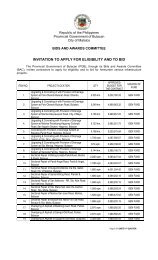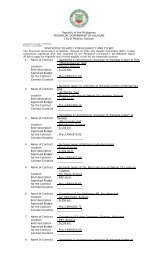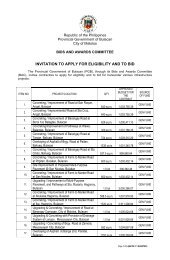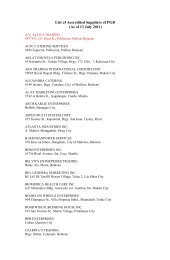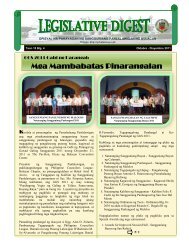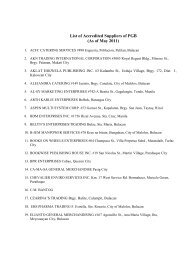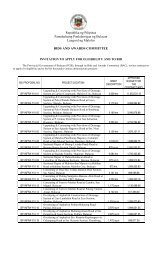Local Legislators' Toolkit - The Sangguniang Panlalawigan ng ...
Local Legislators' Toolkit - The Sangguniang Panlalawigan ng ...
Local Legislators' Toolkit - The Sangguniang Panlalawigan ng ...
You also want an ePaper? Increase the reach of your titles
YUMPU automatically turns print PDFs into web optimized ePapers that Google loves.
q. Residential Lands – public lands intended to or devoted to the construction andestablishment of dwelli<strong>ng</strong>s.r. Zoni<strong>ng</strong> – refers to the delineation or division of a Municipality into a functionalzone where only specific land uses are allowed. It directs and regulates the useof all in the community in accordance with an approved or adopted land use planfor the municipality. It regulates land uses and prescribes limitations onstructures and infrastructures thereon.s. Zoni<strong>ng</strong> Ordinance – an ordinance which classifies, delineates, defines, anddesignates different land uses in the municipality, requiri<strong>ng</strong> fees and imposi<strong>ng</strong>penalties.SECTION 15. Terms Used in the Solid Waste Management. <stro<strong>ng</strong>>The</stro<strong>ng</strong>> followi<strong>ng</strong> termsare conceptually and or operationally defined as follows:a. Garbage – anythi<strong>ng</strong> that is rubbish, trash, and or comi<strong>ng</strong> from food waste thathas the tendency to rapidly decompose and produce offensive odor.b. Refuse – anythi<strong>ng</strong> discarded that is worthless and waste, be it soft or hardmaterials such as bottles, broken glass, tin cans, waste papers, discardedporcelain wares, pieces of metal and other wrappi<strong>ng</strong> and packagi<strong>ng</strong> materials.c. Non-Biodegradable Objects – anythi<strong>ng</strong> that is not capable of decayi<strong>ng</strong> and notabsorbed by the environment such as cellophane, plastics, rubber, metal and thelikes.d. Other Waste Materialsi. Ash – residue or an end product of the process of burni<strong>ng</strong> certain materialthat contributes to air pollution.ii. Dead Animals – lifeless animals such as pets, poultry, swine, rodents and soforth that are not properly disposed and become wastes that adds to air pollution andcaused diseases.iii. Manure – excrement of an animals, which can be generally used for fertilizer.iv. Discarded Buildi<strong>ng</strong> Materials – waste buildi<strong>ng</strong> materials such as nipa andcoconut shi<strong>ng</strong>les, sawali and other materials, which cannot be utilized anymore.SECTION 16. Aquatic Resource Management. <stro<strong>ng</strong>>The</stro<strong>ng</strong>> followi<strong>ng</strong> terms areoperationally and or conceptually defined:a. Aquatic Pollution. <stro<strong>ng</strong>>The</stro<strong>ng</strong>> introduction by man or machine into the grounds orwaters, of substance or energy which results or is likely to result in suchdeleterious effects as to harm livi<strong>ng</strong> and non-livi<strong>ng</strong> aquatic resources and posi<strong>ng</strong>as hazard to human health. It may be a direct or indirect action, or in or out ofparticular local government jurisdictions. It includes dumpi<strong>ng</strong> or disposal of wasteor other matter, carbonaceous materials or substances, oil, coal, coal tar,lampblack, aniline, asphalt, bitumen, mini<strong>ng</strong> and mill taili<strong>ng</strong>s, molasses, garbage,refuse, and other noxious or harmful liquid and gaseous or solid substances.b. Aquatic Resources. Livi<strong>ng</strong> resources of the aquatic environment includi<strong>ng</strong>fishes, aquatic flora and fauna, corals, seals, and ma<strong>ng</strong>roves.c. Fish corral or “baklad”. A stationary weir or trap devised to intercept andcapture fish consisti<strong>ng</strong> of rows of stakes or bamboo, palma brava, or plasticnetti<strong>ng</strong> and other materials fenced with split bamboo matti<strong>ng</strong> or wire matti<strong>ng</strong> withone or more enclosures, usually with an easy entrance but with difficult exit, andwith or without leaders to direct the fish into a catchi<strong>ng</strong> chambers or purse.242



